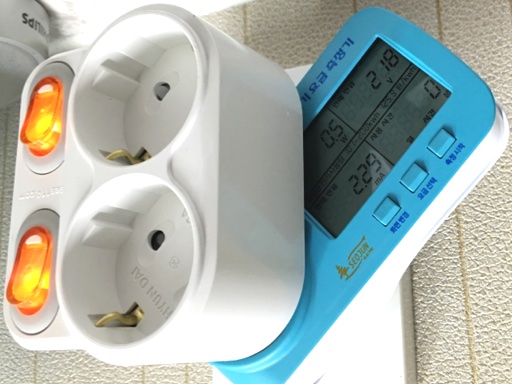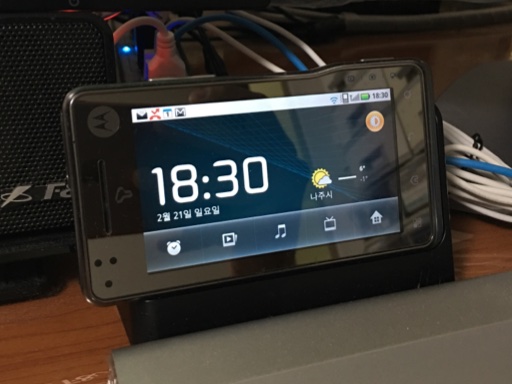Tracking down electricity draw (Part 2)
Posted by Wesley on
Those lights on the power strips do consume power - two for about 0.5W
As it is the case with the houses these days, there are lots of electronic devices littered throughout my home, plugged into wall outlets and USB ports. Measuring how much power these consume in their active and idle states would provide a good starting point in how to cut off unnecessary use of electricity. So that's exactly what I did over several days, and the results from the living room and computer/network equipment are now in. I'll be looking at other appliances as chances allow later on.
I tabulated the full results at the end of this post. But first, I'll talk about some interesting observations worth mentioning.
1. Beware of Light-Embedded Switches on the Power Strips
The lights on the switches of the power strips consume as much power as the devices capable of efficient standby - about 0.2 to 0.25W. This seems excessive for an LED, so I did a bit of searching. It turns out that most of these switches use neon lamps because the operating voltage is around 90V, making it relatively easy to integrate into 220V power using a simple resistor. With a nominal operating current of 1mA, the whole neon lamp + resistor assembly would consume 0.22W = 220V x 1mA.
LEDs, on the other hand, operate around 2 to 3V at 15 to 20mA, being about twice as efficient (neon: 90V x 1mA = 90mW, LED: 3V x 15mA = 45mW). But if you use a resistor to meet the voltage requirement, it would end up wasting much more energy (neon: 130V x 1mA = 130mW, LED: 217V x 15mA = 3,255mW). So you need a power converter instead, but they are neither as cheap or small as a tiny resistor. It's easy to see why neon lamps won out.
If your goal is to waste as little as possible, you would need to avoid having these lights on all the time. If six of these switches are always on, it would equate to about 1.3W, or about 1kWh per month of wasted energy. This is something to keep in mind when choosing a power strip for use in a room. If most of the stuff are used all the time or the standby power is low, it would be better to use a simpler power strip.

Docked smartphone as a desk clock isn't energy efficient - even if it's fully charged
2. Fully Charged Devices Still Leech Power
There are lots of handheld devices out there, and many of them are conveniently charged when placed on a dock. The problem is that even when the device is finished charging, the charging circuit still draws some power to keep the battery topped off.
For one thing, my electric shaver was found to be sitting idle and sipping nearly 1W for several hours even after being fully charged. Considering that it only takes a few minutes at most to get back to full after a shaving session, this seems to be an unneeded waste. I've changed my usage pattern so that I charge the shaver once every other week or so, and cut the power to the charger once I see that it's done its job.
Then there's the Motoroi smartphone that I've been keeping around its vertical dock as a desktop clock for about five years ever since it was no longer my main phone. The measurement showed that, even though it's kept fully charged, it was drawing about 1.2W from the USB hub all the time because the screen was always on. Like the power strip lights, this is enough to affect the last digit of my monthly electricity usage. So I decided to retire the old phone and replace it with a normal digital clock.
Similar to what was going on with Motoroi and the shaver, smartphones plugged into the dock were also found to sip a bit of power after a full charge. Unplugging it after charging seems to be the "smart" thing to do.
3. Find a Power Efficient Mode If Possible
As I explored on the last post, I was able to find a power-saving feature on the living room TV, cutting 40% of power from normal use. There was a similar feature on the main computer monitor (the 23" LED one), so I decided to start using this feature as well. One downside is that the colour accuracy and contrast sometimes suffer as it tries to dynamically optimize power usage. This is fine for web browsing, but I'll be turning it off while I do photo editing.
In the case of my 12-year old 17" secondary monitor that I occasionally use, it consumes 0.7W of standby power even when it's turned off, which is quite a bit more than more recent models. Luckily, there is a master power switch on the back that cuts the power off completely. I'll be using this when the monitor isn't in use.
Meanwhile, the Nintendo Wii game console had been wasting 9.4W when it entered standby. This was due to a feature called WiiConnect24, which enables the console to connect to the internet during standby mode. As interesting this sounds, it was discontinued in 2013, making it zero sense to keep it on in the system settings. It got turned off right away.
Speaking of waste, the set top boxes for the IPTV and satellite TV services are prime examples - their notoriety have been reported on popular media before. Even when they're set to standby, the power consumption level hardly drops, so all this does is apparently not much more than just cutting off the video. Cutting power outright is the only reasonable path to take when you're not watching.
4. The Grand Table of Power Consumption
Finally, here is the comprehensive data I've collected for the devices I have at home. I listed the specific model number for your reference, but I expect that each device can also serve as a rough representation of its class. All values are in watts (W).
| Type | Name | Off | Idle | Active | Rated |
|---|---|---|---|---|---|
| Displays | |||||
| 32" LED TV | TIFIVE SA-320FHDC | 0.4 | 36.0 | 38.0 | 60.0 |
| 46" LCD TV | Samsung LN46A550P1F | 0.6 | 102.4 | 170.2 | 230.0 |
| (Energy Saving Mode) | 53.4 | 85.4 | |||
| 23" LED Monitor | LG Flatron IPS237L-BN | 0.2 | 1.4 | 27.8 | 31.4 |
| (Energy Saving Mode) | 22.8 | ||||
| 17" LCD Monitor | Samsung SyncMaster 176N | 0.7 | 2.8 | 32.0 | 42.0 |
| Set Top Boxes & Players | |||||
| Satellite (KT) | LG SN730H-SS (HD-0603) | 8.0 | 9.0 | 9.2 | 24.0 |
| IPTV (SKB) | Samsung SMT-E5030 | 8.8 | 9.0 | 9.4 | 24.0 |
| Media Player | Apple TV 3rd Gen (A1469) | 0.7 | 1.1 | 1.41 | 30.0 |
| Blu-Ray Player | LG BP440 | 0.2 | 5.0 | 5.4 | 12.0 |
| (No Disc Inserted) | 4.3 | ||||
| Game Console | Nintendo Wii RVL-001 | 1.7 | 16.4 | 17.6 | 45.0 |
| (Standby Connection On) | 9.4 | ||||
| Digital Piano | Kurzweil M1 Plus | 0.3 | 8.8 | 9.0 | 60.0 |
| Network Equipment | |||||
| Wi-Fi Router | D-Link DIR-850L (802.11ac) | 0.22 | - | 4.5 | 24.0 |
| VoIP Gateway3 | DavoLink DV-301A | - | - | 3.5 | 10.0 |
| G-PON ONT4 | Dasan Networks H655 | - | - | 3.1 | 10.0 |
| Home Gateway5 | Samsung SDS SHN-3017XM | - | - | 6.6 | 10.0 |
| Computer & Peripherals | |||||
| Computer | Mac mini (Late 2012, i7) | 0.3 | 12.2 | 70.06 | 85.0 |
| External HDD | Sarotech FHD-362U3-6G Seagate Desktop HDD 4TB |
2.1 | 5.2 | 8.6 | 24.0 |
| Inkjet Printer | HP Deskjet 1510 (Main) | 0.2 | 2.0 | 8.0 | 10.0 |
| HP Deskjet 1510 (USB) | 0.0 | 0.2 | 0.2 | 2.5 | |
| HDTV Tuner | Pinnacle PCTV HD Stick 800e | - | 0.6 | 3.1 | 2.5 |
| Webcam | Krizer HDCAM 1500-UVC | - | 0.4 | 0.6 | 2.5 |
| Soundbar | Canston F&D E30 | - | 0.2 | 2.07 | 2.5 |
| HDMI-to-VGA8 | Comms FW434 | - | 0.6 | 1.0 | 2.5 |
| IP Camera | Xiaoyi Smart Camera 750TVL | - | - | 1.6 | 2.5 |
| (Night Mode: IR LED On) | 2.3 | ||||
| Keyboard | Apple Keyboard (A1243) | - | - | 0.7 | 2.5 |
| 10P USB Hub | EzNet NEXT-510UHP | - | - | 0.2 | 20.0 |
| Mobile Devices: Standby (Charged) / Idle (Charged) / Charging | |||||
| Smart "Clock" | Motorola Motoroi XT720 | 0.8 | 1.2 | 4.3 | 2.5 |
| Smartphone | Apple iPhone 4 (A1332) | 0.6 | 1.6 | 2.5 | 2.5 |
| Electric Shaver | Philips Speed-XL HQ8160 | 0.1 | 0.9 | 4.3 | 9.0 |
| Charging & Outlet | |||||
| 2P Power Strip | Hyundai Elec HT115 | 0.0 | 0.5 | - | 2,600 |
| 4P USB Charger | O2E Company 050500 | 0.2 | - | - | 25.0 |
[ Terminologies & Explanations ]
Off: The device is turned off with its power switch, or just connected to the power and not showing any signs of operation. Most of the cases, it's in standby mode.
Idle: You can tell that the device is turned on (e.g. power light or screen is on, immediately responds to commands, etc.), but isn't doing anything.
Active: The device is actively working to do what it's supposed to do (e.g. recording a TV show).
Rated: How much the power supply or the device is rated to draw electricity at maximum.
1. Obtained when streaming a movie online.
2. Unlike other network equipment in the house, this had an on/off switch. This was measured when the switch is set to off - this standby power is being consumed by its external power supply.
3. VoIP Gateway connects regular telephone to Voice over Internet Protocol (i.e. internet phone) service.
4. G-PON ONT stands for Gigabit Passive Optical Network - Optical Network Terminal, and it converts fiber-optic signals to Ethernet connection at my home.
5. Home Gateway connects "smart home" equipment in the house and other equipment / data sources on the apartment building together.
6. Obtained while playing Goat Simulator game. It's usually much lower most of the time.
7. Obtained with music playing at maximum volume. Moderate sound only consumes slightly above idle level.
8. HDMI-to-VGA adapter is used to convert digital HDMI video signals (from my Mac) to analog VGA signals (for the old 17" monitor that doesn't even have DVI).